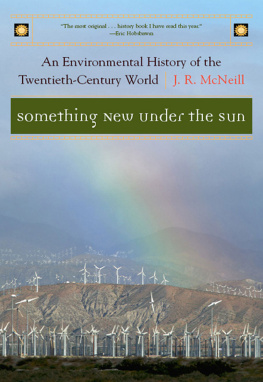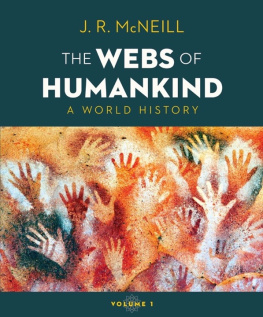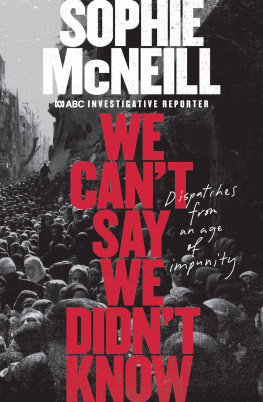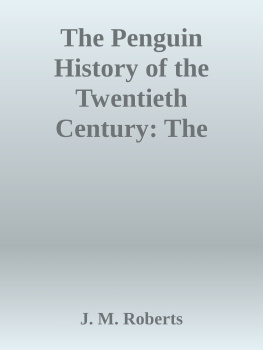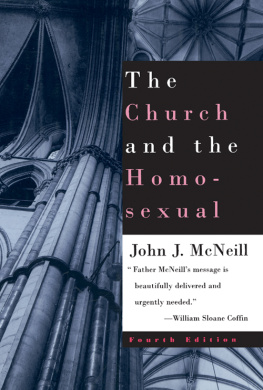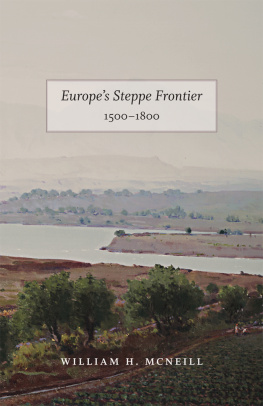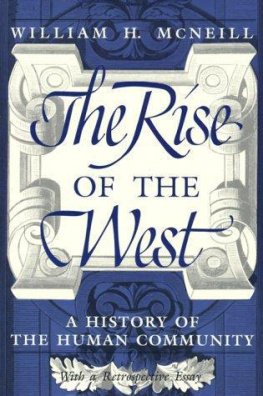ALSO BY J. R. M C NEILL
SOMETHING NEW
UNDER THE SUN
A N E NVIRONMENTAL H ISTORY OF
THE T WENTIETH -C ENTURY W ORLD
J. R. M C N EILL
W. W. NORTON & COMPANY NEW YORK LONDON
Copyright 2000 by J. R. McNeill
All rights reserved
For information about permission to reproduce selections from
this book, write to Permissions, W. W. Norton & Company, Inc.,
500 Fifth Avenue, New York, NY 10110
Library of Congress Cataloging-in-Publication Data
McNeill, J. R.
Something new under the sun: an environmental history of
the twentieth-century world / J. R. McNeill.
p. cm.
Includes bibliographical references.
ISBN: 978-0-393-07589-2
1. Human ecologyHistory20th century. 2. NatureEffect
of human beings onHistory20th century. I. Title.
GF13.M39 2000
304.280904dc21
99-054900
W. W. Norton & Company, Inc., 500 Fifth Avenue,
New York, N.Y. 10110
www.wwnorton.com
W. W. Norton & Company Ltd., 10 Coptic Street,
London WC1A 1PU
for Julie,
ONCE AGAIN
Contents
List of Maps and Tables
M APS
T ABLES
Foreword by Paul Kennedy
At the beginning of the twentieth century, humankind in the West had already become aware that its collective economic activities were doing strange things to the environment. Salmon could no longer migrate upstream through chemical-tainted waters. The air surrounding industrial citiesand further afield, as the winds moved onwas full of particles of burned fossil fuels. Smog took the lives of thousands with respiratory problems each year. Huge gashes had been carved in the landscape to gain access to fresh coal supplies, and ugly heaps of slag blotted once-pleasant countrysides.
The twin sources of this environmental havoc were also known to observers in 1900. The first was that the worlds human population, which had grown rather slowly for almost four million years, began to accelerate in the late eighteenth century and still showed no signs of slackening. The second was that human economic activity had also accelerated ever since the post-1760 Industrial Revolution had allowed the substitution of inanimate for animate energy. All this caused intellectuals like the Cuban Jos Mart and the Englishman H. G. Wells to wonder whether this immense surge in human activities could be sustained in the decades to come without degrading nature.
Had such writers survived another 100 years, they would have been amazed at the even-greater pace of change that the twentieth century witnessed. The worlds population quadrupled in that time, the global economy expanded 14-fold, energy use increased 16 times, and industrial output expanded by a factor of 40. But carbon dioxide emissions also went up 13-fold, and water use rose 9 times. Not all of this meant bad newsindeed the productivity increases of the twentieth century raised the living standards of hundreds of millions of human beings out of their forefathers ghastly povertybut the sheer size and intensity of the transforming processes also meant that the history of the twentieth century really was different, in environmental terms, from that of any preceding periods.
The twin challenge to all intelligent world citizens is, first, to understand the sheer dimensions of environmental change (and the many results thereof) in this past century; and, second, to think sensibly about how these problems might be addressed before dangerous thresholds are breached by our unwitting, collective activities. This message of first comprehending and then responding to environmental change is the hallmark of Professor McNeills brilliant and remarkably concise examination of the past century. As his title makes clear, at least in this case Ecclesiastes may have been wrong in claiming that there was nothing new under the sun. For what McNeill demonstrates in the seven chapters of Part One is that in all of the spheres that surround usthe lithosphere and pedosphere, the atmosphere, the hydrosphere, and the biospherewe humans have impacted our planet more deeply in the twentieth century than we did in all previous history combined. One statistic alone sums this up: according to McNeills (rough) calculations, humans in the twentieth century used ten times more energy than their forebears over the entire thousand years preceding 1900.
But Professor McNeill is not a mere recorder of environmental change. What really interests him is the interaction between what he calls the planets history and the peoples historywhich is why the chapters in Part Two of this book are equally, perhaps even more, important. Here he deftly analyzes the elements of population growth, migration, technological change, industrialization, international politics, ideasand their many feedback loops into the realm of environmental policies.
McNeill is neither a Luddite, nor a dogmatic no-change-at-all environmentalist. But he does caution us to be prudent, and to take action , lest the ecological thresholds that global society is steadily approaching are in fact closer than we think.
Something New Under the Sun is a clearly written and immensely insightful book. It carries a message that is deeply sobering, and deserves the widest attention from publics and politicians alike.
Acknowledgments
Without the help and support I received on it, this book would not have been ready until well into the twenty-first century, and it would have been a longer and lesser book. Several of my colleagues in the History Department at Georgetown University critiqued the manuscript, in most cases in its entirety, which claimed a good chunk of their time in the summer of 1998: Tommaso Astarita, Carol Benedict, Emmett Curran, Catherine Evtuhov, Alison Games, David Goldfrank, Andrzej Kaminski, David Painter, Aviel Roshwald, Jack Ruedy, Jordan Sand, Jim Shedel, Judith Tucker, John Tutino. Their collective expertise saved me from countless embarrassments. Other Georgetown colleagues read sections of the manuscript with equally helpful effects: Janice Hicks of the Chemistry Department; Martha Weiss from Biology; Tim Beach, Murray Feshbach, and Richard Matthew of the School of Foreign Service; and Steve King of the Government Department. I feel fortunate to work at a university where colleagues cheerfully shoulder burdens such as those I placed on this group.
Several of my students at Georgetown in 19981999 read parts of the manuscript andgleefullyfound ways to improve it: Dan Brendtro, Eric Christenson, Julie Creevy, Brett Edwards, Katie Finley, Justin Oster, and Jill Wohrle. Students from another time, the early 1990s, hooked me on world environmental history by their enthusiastic work in the best class I have ever taught: Sean Captain, Brad Crabtree, Nancy Golubiewski, Elena Garmendia, and Terri Willard. They helped spur me on by asking about progress on the book as the years ticked by.
Friends, relatives, and colleaguespleasantly overlapping categorieselsewhere who read all or parts of the manuscript and improved it include Peter Campbell, Bill Cronon, Rebekah Davis, Don Hughes, John Kelmelis, Greg Maggio, Bob Marks, Elizabeth McNeill, William McNeill, and Kent Redford. I am also grateful to Alison Van Koughnett and George Vrtis for their help in sending useful research material my way.
I was able to work full-time on this book for two consecutive years thanks to the generous support of several institutions. The Fulbright program made possible six months work in New Zealand, spent in the delightful environment of the University of Otago History Department. I thank Rob Rabel and Erik Olsen for arranging and smoothing my stay on the riviera of the subantarctic, where serious thinking on the book began. The Woodrow Wilson International Center for Scholars granted me a fellowship in 19961997 and provided a bracing intellectual environment, especially at lunchtimes. Many of the Fellows from that year helped me along in my work, most notably Temma Kaplan and Wolf Fischer. The Wilson Center also provided research assistants who made my task far easier: Christian Kannwischer, Peter Kocsis, Angeliki Papantoniou, and Toshuko Shironitta. In 19971998 the Guggenheim Foundation provided fellowship support which allowed me to stay holed up in my attic and complete the first draft of the manuscript. And Georgetown University granted me leave of absence for these two years, as well as additional research support over the years.

